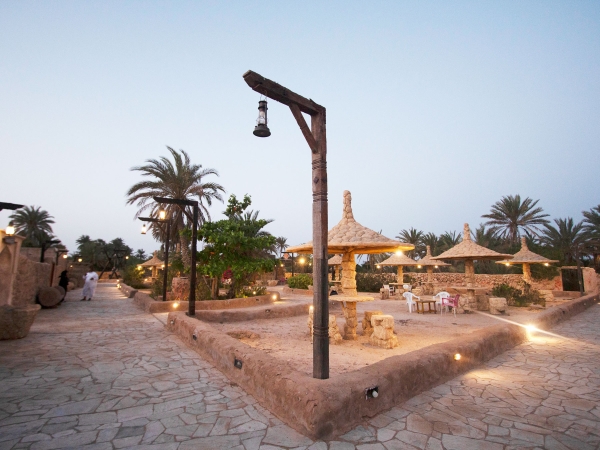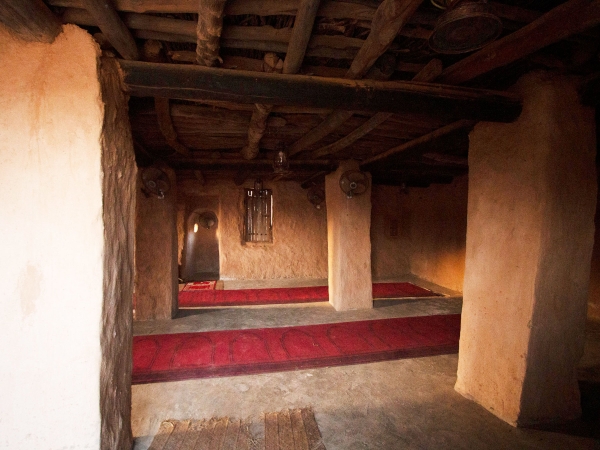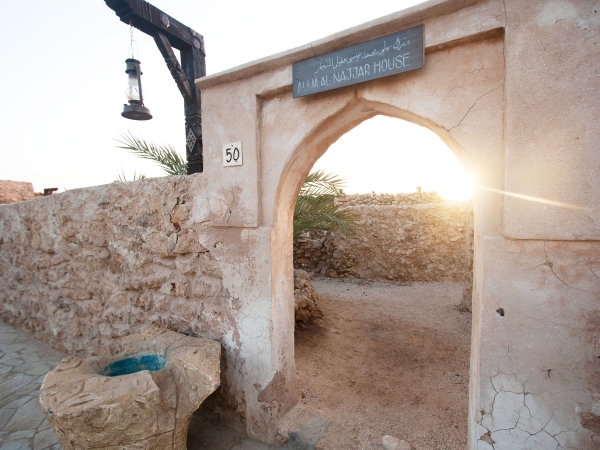



Al-Qassar Heritage Village is located on Farasan Island affiliated with Jazan Province, south of the Kingdom of Saudi Arabia. It is famous for its abundance of palm and perennial trees. It is one of the most important villages on Farasan Island and one of the first sites to be inhabited on the island hundreds of years ago due to its moderate weather throughout the year, the abundance of palm and perennial trees, as well as freshwater extracted from several wells in the village for drinking and irrigation of farms purposes.
Tourism in al-Qassar Heritage Village
Al-Qassar Heritage Village is a tourist site. Its heritage buildings constructed of stones and palm leaves, and surrounded by palm trees, have made it an attractive destination for tourists. The village is located about five km south of Farasan Island, and tourists can reach it via Janaba Corniche and al-Hafah Marina.
The village is a summer resort for the residents of Farasan Island. They spend more than three months there during the stormy season known as 'al-Assef', which is when the summer winds of the north blow announcing the wet tropical season that water the palm trees. Moreover, the village is distinguished by the freshness of its groundwater and its proximity to the surface of the earth, as its depth does not go below seven m.
Ruins of al-Qassar Heritage Village
Researchers in al-Qassar Heritage Village found a set of ruins containing inscriptions carved on some of the stones in the Himyari script, other inscriptions in ancient Latin letters, and some inscriptions dating back to the year twenty-four BC in al-Kadmi area located there. Writings in the southern Musnad script were also found dating back to the Himyarite era, as well as ruins dating back to the Roman era, a number of drawings and writings, some of which date back to the Himyarite era, in addition to the ancient fort dating back to the late Islamic period.
Wells in al-Qassar Heritage Village
The village of al-Qassar is of great importance to the people of Farasan Island due to its moderate climate throughout the year, and abundance of fresh water in its cold wells which were dug for drinking and irrigation farms purposes, most notably 'Aabida' well, located at the northern entrance to the village. This is in addition to a few small shops, 'al-Dakakin', where the village's food supplies were sold.
Social life in al-Qassar Heritage Village
In the village of al-Qassar, the people of Farasan celebrated marriage ceremonies that had been postponed for a year until the season of departure from Farasan Island to al-Qassar village came in the summer. This season, known as the 'Shidda' (hardship) season, was a time to escape the intense heat. In al-Qassar, there was an abundance of water, fruits, and the shade of palm trees. The village square and the houses, which were built with stone walls, provided shelter. These houses had roofs made of wood and palm fronds, and their courtyards were decorated with white sea shells, known as al-Batah, which covered the entire area of the walls surrounding the house. The walls were also built of stones and adorned with distinctive Persian engravings.
Building al-Qassar Heritage Village
The village of al-Qassar is home to a number of neighborhoods. Every neighborhood includes a group of stone houses, each consisting of a stone house whose area does not exceed twenty m. These stone houses are referred to as Bayt (home) and serve as the main residence for families. The total number of homes in the village is about four hundred, and all the walls of the houses were built of carved and trimmed stones. The roofs were made of the trunks of palm trees or the Hyphaene, as well as palm branches or sticks of Anisotes. Moreover, Khabban, which are large masses of seaweed, were added.
Restoration of houses in al-Qassar Heritage Village
The village witnessed the development and restoration activities of its houses, squares, and archaeological sites, in accordance with its urban design. This made it a cultural landmark that tells the history of the village and the journey that the people of Farasan took at the beginning of every summer.
Related quizzes
Related articles
